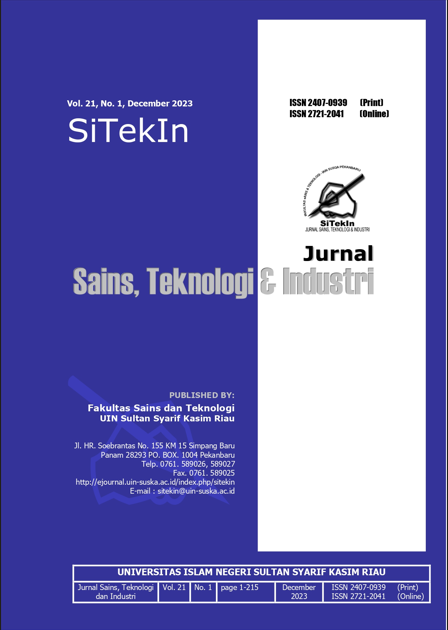Modified Leslie-Gower Model with Holling Type I Functional Responses and Cannibalism in Prey
DOI:
https://doi.org/10.24014/sitekin.v21i1.24529Abstract
The predator-prey model is the mathematical model that describes the interaction behavior between prey and predator. This research discusses the modified Leslie-Gower model by considering the cannibalism behaviors of the prey that contains Holling type I response function, which is a predator with passive characteristics. The stability analysis stage includes determining the system's solution in the form of an equilibrium point, analyzing the local stability of each equilibrium using eigenvalues, and numerical simulation to synchronize the analysis results. Numerical simulations visualized in phase portraits with Python software. The results of the local stability analysis of the system obtained four equilibrium points, namely, equilibrium points are unstable while is asymptotically stable with certain conditions. The results of numerical simulations show that only the equilibrium point which is asymptotically stable when the environment carries capacity parameters (e=2.1). Meanwhile, when e=2.878 then, only is asymptotically stable. In this research also using two different initial values, it is concluded that whatever the initial value used, the system solution always converges to the equilibrium points dan . Changes in environmental carrying capacity affect the dynamics of system solutions.
References
E. N. L. Nurhamiyawan, Helmi, and B. Prihandono, “Analisis Dinamika Model Kompetisi Dua Populasi yang Hidup Bersama di Titik Kesetimbangan Tidak Terdefinisi,” Bul. Ilm. Mat. Stat. dan Ter., pp. 197–204, 2013.
K. Amri and T. Sihombing, Mengenal dan Mengendalikan Predator Jenis Ikan. Jakarta: Gramedia Pustaka Utama, 2008.
L. R. Fox, "Cannibalism in Natural Populations," Annu. Rev. Ecol. Syst., pp. 87–106, 2003.
Suharyanto, Y. Aryati, and S. Tahe, “Upaya Penurunan Tingkat Kanibalisme Rajungan (Portunus pelagicus) Dengan Pemberian Suplemen Triptofan,” J. Perikan. (Journal Fish. Sci., pp. 126–133, 2008.
L. Umar, “Pengaruh Ukuran Benih Terhadap Pertumbuhan Sintasan dan Tingkat Kanibalisme Ikan Nila,” SIGANUS J. Fish. Mar. Sci., pp. 240–245, 2022.
D. H. Wise, "Cannibalism, Food Limitation, Intraspecific Competition, and The Regulation of Spider Populations," Annu. Rev. Entomol., pp. 441–465, 2006.
M. Taylor, T. Larsen, and R. E. Schweinsburg, "Observations of Intraspecific Aggression and Cannibalism," Arctic, pp. 303–309, 1985.
V. Trisnasari, Subandiyono, and S. Hastuti, “Pengaruh Triptofan Dalam Pakan Buatan Terhadap Tingkat Kanibalisme Dan Pertumbuhan Lobster Air Tawar (Cherax quadricarinatus).,” J. Sains Akuakultur Trop., pp. 19–30, 2020.
A. Basher, E. Quansah, S. Bhowmick, and R. D. Parshad, "Prey cannibalism alters the dynamics of Holling–Tanner-type predator–prey models," Springer, pp. 2549–2567, 2016.
H. Deng, F. Chen, Z. Zhu, and Z. Li, "Dynamic behaviors of Lotka–Volterra predator-prey model incorporating predator cannibalism," Adv. Differ. Equations, 2019, doi https://doi.org/10.1186/s13662-019-2289-8.
M. Rayungsari, W. Muharini, A. Suryanto, and I. Darti, "Dynamical Analysis of a Predator-Prey Model Incorporating Predator Cannibalism and Refuge," Axioms, 2022.
C. S. Holling, "Some characteristics of simple types of predation and parasitism," Can. Entomol. 91, pp. 385–398, 1959.
D. Hadley, “10 Fakta Menarik Tentang Kepik,” 2019. https://id.eferrit.com/10-fakta-menarik-tentang-kepik/ (accessed Mar. 24, 2023).
P. H. Leslie and J. C. Gower, "The properties of a stochastic model for the predator-prey type of interaction between two species," Biometrika (1960), 47, 3 4, p. 219, 1960.
N. H. Du, N. Man, and T. . Trung, "Dynamic of Prey-predator population with modified Leslie-Gower and Holling-Type II Schemes," Acta Math. Vietnamica, vol. 32, pp. 99–111, 2007.
A. B. Ashine, "Prey-Predator Model with Holling-Type II and Modified Leslie-Gower Schemes with Prey Refuge," African J. Basic Appl. Sci., 2016.
W. E. Boyce, R. C. Diprima, and D. B. Meade, Elementary Differential Equations and Boundary Value Problems, 11th ed. Wiley, 2016.
Downloads
Published
Issue
Section
License
This work is licensed under a Creative Commons Attribution-ShareAlike 4.0 International License
Copyright Notice
An author who publishes in the SITEKIN Journal agrees to the following terms:
- Author retains the copyright and grants the journal the right of first publication of the work simultaneously licensed under the Creative Commons Attribution-ShareAlike 4.0 License that allows others to share the work with an acknowledgement of the work's authorship and initial publication in this journal
- Author is able to enter into separate, additional contractual arrangements for the non-exclusive distribution of the journal's published version of the work (e.g., post it to an institutional repository or publish it in a book) with the acknowledgement of its initial publication in this journal.
- Author is permitted and encouraged to post his/her work online (e.g., in institutional repositories or on their website) prior to and during the submission process, as it can lead to productive exchanges, as well as earlier and greater citation of the published work (See The Effect of Open Access).
Read more about the Creative Commons Attribution-ShareAlike 4.0 Licence here: https://creativecommons.org/licenses/by-sa/4.0/.

